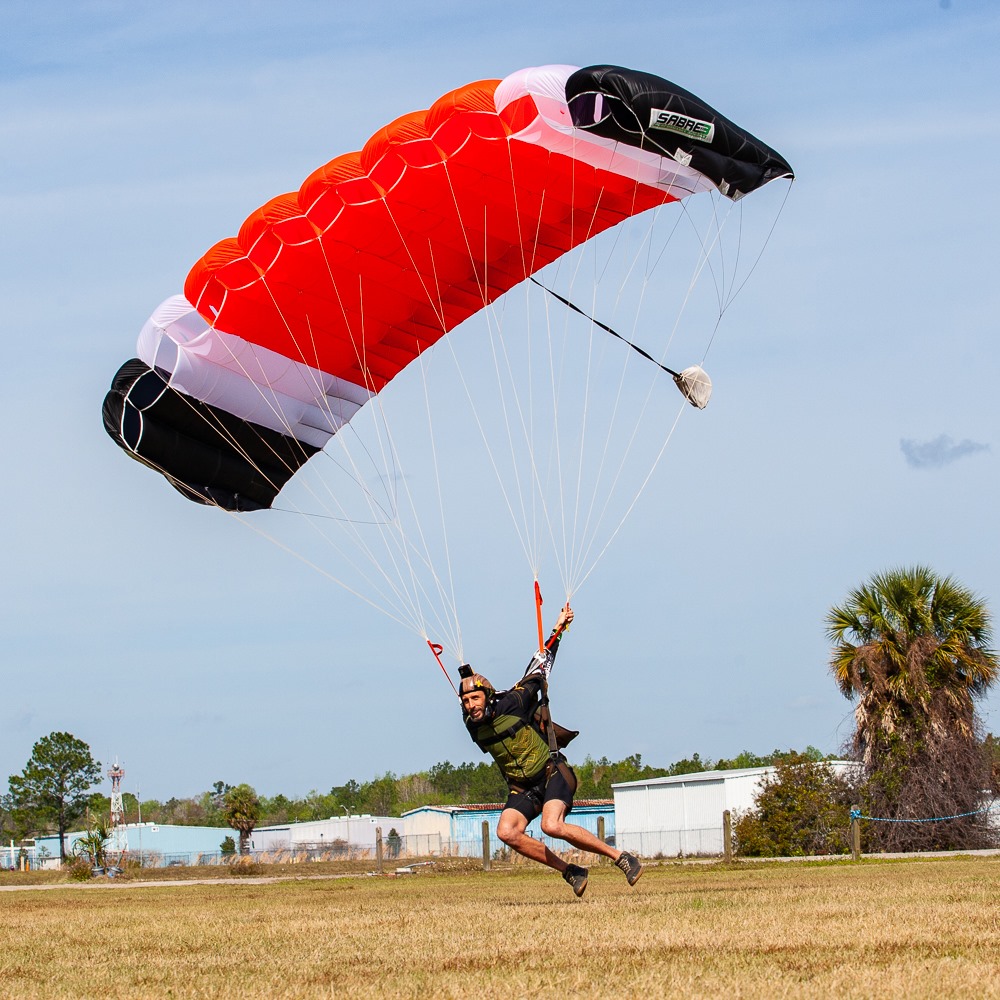Paul Dorward, Flight-1 instructor, gives us some pointers to improve our landings…

As a full time canopy coach, I am often asked, “What are your top tips for a better landing?”
I love this question as it shows engagement. Perhaps it’s sometimes born out of frustration but that’s okay too – having the desire to be better is half the battle.
Tip 1 – Learn at a canopy course

The first point you really need to identify with is, how do you define a better landing?
- Do you wish to be more accurate?
- Do you wish to land faster?
- Or land slower?
- Or is it as simple as, you want to land on your feet consistently?
The number 1 tip is of course to book yourself on to a canopy course, where the coaches can look in detail under a microscope and assist your learning in the most efficient way possible. Never underestimate the power of an outside detailed view.
Tip 2 – Positive mindset

A great landing starts with a positive mindset. Have you been in the plane dreading the canopy ride, talking yourself into a less than favourable landing? Or do you keep re-running the same scene in your head, where you fall over or miss the target and you think everyone’s laughing at you or, worse still, it hurts. The power of a positive mind has been studied and proven to aid performance. Try imagining the most amazing landing; the perfect flare in the perfect place, that tip-toe soft touchdown arrival, and walking away in two steps. You’re heading back to the hangar and you see people giving you that nod of approval. So, before your jump you go through the usual routine, dirt-dive, gear up, exit practice, check your gear and each other… add another step, tap into that positivity! Rather than the usual, ‘Oh God, here comes the landing’, think back to that ideal example, and imagine yourself doing it, really focus on seeing yourself pull off the perfect landing. Sometimes the only thing holding you back is the way that you are thinking.
Sometimes the only thing holding you back is the way that you are thinking
Tip 3 – Fly a good pattern

Photo by Pete Allum
No great landing ever started with a poor pattern. Time and time again I see people slowly abandon the pattern over a period of time or jumps. Perhaps the pattern has a stigma attached to it as we were taught it as newbies. It just seems so ironic that the so-called ‘better’ we get at skydiving, sometimes the worse our pattern behaviour becomes. Just take a look at a couple of loads at your local DZ with an objective view and ask yourself, does anyone know what’s going on up there? Of course there are many great examples too, but can you sit with a coffee and perhaps identify a couple of jumpers that are going crazy? Does it look right? Does it look familiar to your own flying style?
We teach pattern work from first-timers all the way to people with 10,000 jumps and beyond. If you can’t be in the right place at the right height at the right time, then your landing and perhaps the landings of others can be in serious jeopardy.
Everyone should have a minimum 4-point pattern, Holding Area – Downwind – Base – Final.
Tip 4 – Look at the horizon

Photo by Peter Tornestam
As you are approaching on finals, how many times do you catch yourself looking down at the ground? This is a natural instinct, as the ground can hurt. I challenge you to look forwards at the horizon. Try and pick up some more peripheral information, perhaps develop a better depth perception. You may notice that your eye level drifts back down to the ground and, hey that is okay, so long as you keep referencing the horizon. Without this peripheral information we have a hard time judging when to start the flare. Look up; chin, chest and eyes forwards.
Tip 5 – Keep the wing level

Image: Luis Prinetto by Scott Jontes
Remember the landing priorities, in this order:
- With the WING LEVEL
- Into an open area
- Face into wind if possible.
Think body position – as you begin your landing flare and level off, it’s very important to keep your body weight over your hips and feet. If you think back to the student flare you were taught in your initial training, it was usually just one pull on the toggles all the way to fully flared. Your body swings forward of the wing, your hands are down in by your groin and you’re almost leaning backwards. No surprise, you are then likely to fall backwards as you touch down.
Try to set yourself up so your chin, chest and eyes lead by leaning forward in the harness. This will allow your centre of mass to stay over your feet so as you touch down you are way more prepared to take a few steps on landing, staying upright throughout. Once you have touched down and made the best landing you could imagine, remember it’s not over until you’re back in the hangar; turn around, look up at the canopies on finals and don’t become a hazard for others! Stowing your brakes can wait until you know the skies are clear.
Summary
To summarise, you can grind at it alone or you can engage with a coach. A good coach will resonate with you, allow you to learn at your own pace and help you discover what works for you, at your experience level and with your current equipment.
Happy landings!

Photo by Ioannis Vlachiotis


